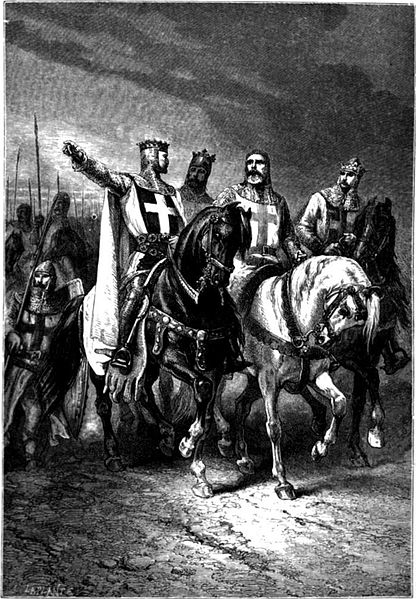*Image Credit: Wikimedia Commons The first of several religious wars in the Middle East among Christians and Muslims, the First Crusade created a rift between two cultures that continues to this day. On July 15, 1099, at the end of a bloody siege on Jerusalem, knights from Europe launched a massive assault on both sides of the city, meeting at the Church of the Holy Sepulchre, bringing the Holy War to a close. More than a month before, the Crusaders had arrived on the outskirts of Jerusalem. Having faced little in the way of resistance while moving along the coast of the Mediterranean, many of the knights cried tears of joy when finally laying eyes upon their stated goal. On June 7th, the siege unofficially began, despite the fact many of the Europeans were wary of the dry, open plain and a severe lack of water and food. Less than 12,000 men had survived the long journey from Europe and, of those that did, deep tensions existed due to the wide variety of nationalities present. Armies of Godfrey du Bouillon and Tancred of Taranto set up camp on the northern edge, with Raymond of Toulouse and his men settling on the opposite side. It would take six days for the first assault to be launched – one that would not include the southern contingent for unknown reasons. Though the first wave managed to scale the external wall of the city, the ruling Muslims soon pushed them out. Four days later, on June 17th, a meeting scheduled among the leadership of the Crusaders yielded an agreement to attack in a more organized, complete manner in the future. Aided by a group of engineers and mariners from Genoa, the Europeans were able to build siege engines from lumber pulled from the Italian ships at Jaffa. The boost in morale – aided by a prophesy from Peter Desiderius echoing the collapse of Jericho in the book of Joshua – led the men to try plan another assault for July 8th. Once again fighting amongst themselves, the effort failed. Word soon arrived from Egypt that reinforcements would soon be arriving, giving the Crusaders a significant reason to pull together and finish the job. It took a further five days, but another assault on the city walls began July 13th with Raymond’s army launching itself at the South Gate and the men under Godfrey and Tancred attacking the northern walls. Despite intense resistance, the Christian soldiers slowly made headway, until a final push on July 15th forced defenders on the inner walls to drop their weapons and run. With the Crusaders now sweeping into the city, the violence increased dramatically – blood flowed in the streets as knights moved from place to place hacking their adversaries to pieces. While their men ran rampant through the streets of Jerusalem, leadership made its way to the Church of the Holy Sepulchre – the site tradition holds Jesus was crucified – in order to negotiate the establishment of a new Christian government. One week later, the Kingdom of Jerusalem would be established with Godfrey du Bouillon as its king.
July 15, 1099 CE – The First Crusade Ends at the Church of the Holy Sepulchre
*Image Credit: Wikimedia Commons The first of several religious wars in the Middle East among Christians and Muslims, the First Crusade created a rift between two cultures that continues to…
535
